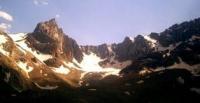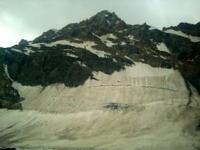Вы здесь
Glaciers in Fany Mountains.


Tajikistan Tours & Travel.
“How glorious a greeting the sun gives the mountains!”
John Muir. «The Mountains of California».
Adventure travel Tajikistan.
As already mentioned, the modern glaciers of the Fany Mountains are only a faint trace of that great glaciation, which, like a shell, covered the present flowering valleys in former times. But even now, up to a hundred glaciers descend from the Gissar and Zeravshan ranges.
This ice cover continues to shrink rapidly, and all glaciers are in retreat. Their previous size can be determined from the preserved terminal and bottom moraines. A large glacier covered the entire Kulikalon depression, and it is a continuous bottom moraine.
This glacier filled the terminal moraine at the headwaters of the Artuch River. Retreating and shrinking, the glacier split into two streams. The moraine lake Kulikalon and several short glaciers in the sinuses of the Kulikalon wall, south of the lake, remain from the first.
The second stream began from the walls of the Mirali peak. Its terminal moraine is visible over Lake Bibi-Jonat. From this glacier, there remained the Dushakh moraine lakes, the short Maria glacier and the hanging glaciers under the slopes of the Intermediate peak.
The gorge of the Chapdara River had a large glaciation. The glacier descended below the Alaudin lakes. Its terminal moraine is currently overgrown with forest, and Chapdara is overthrown from it in a cascade. Retreating, the glacier had periods of equilibrium in the process of melting, successively deposited terminal moraines over the Big Alaudin Lake and higher - in the form of three moraine banks. The gaps between the ramparts are filled with bottom sediments with numerous moraine lakes, preserved and dried up.
Above the Second Wall, the glacier split. One branch fed on recruits from the slopes of Chapdara Bodhona and Castle (northern slopes). The high yellow moraine and the fresh moraine of the modern Bodkhona glacier remain in memory.
From the second branch remained the Payhamber and Zamok glaciers. The largest branch united the glaciers of the Mutny Lakes Circus. The final moraine of this glacier is the Third Wall. This glacier also retreated, leaving a bottom moraine between the Third Wall and Mutny Lakes.
At present, four glaciers descend to the Mutny Lakes from the slopes of the Kaznok pass and the peaks of Energia, Chimtarga and Mirali. A curious glacier descends from the Chimtarga ridge, divided into two tongues at the bottom.
The group of glaciers Surkhob-Imat feeds on firns of the northern slopes of the Big and Small Hansa. Old seas of the Yellow and Imat glaciers can be traced near the mouth of the Yellow River. Currently, the glaciers continue to retreat.
The Yellow Glacier has a calm flat surface and small narrow cracks. It is convenient to walk along it. In the gorge of the Turzul River, a glacier descends from the slopes of the Sarof peak. A whole group of glaciers descend into the Zinakh gorge.
There is a beautiful icefall on the Terrible glacier, which can be easily bypassed along the lateral moraine. Along the gorge of the Left Zindon, the glacier descended to Lake Bolshoye Allo, where its terminal moraine was located. This moraine was blocked by a blockage, and the Big Allo lake became a blockage lake.
Above the gorge, several moraine lakes have been preserved. From the former glacier, there is a short steep glacier descending from the Dvoynaya pass. An interesting picture is revealed by the history of glaciation of the Iskander-Kul - Sarytog - Karakul system.
Along the gorge of the Iskanderdarya river, the glacier extended below the Iskanderkul lake. Its terminal moraine is clearly marked. The gorge of the Serima River was blocked by a lateral moraine, behind which Lake Zamin-Mulla was formed.
The second terminal moraine, 250 m high, blocks the gorge of the Sarytog river above the Iskander-Kul lake. The Sarytoga valley was a lake. Moraine deposits are clearly visible along the river Apr. A glacier descended from the upper reaches of the Kaznok, the terminal moraine of which (Teppa) is located near the mouth of the Biob River and significantly rises above the Arga gorge.
Now the glacier has retreated very far, and only in the upper reaches of the Kaznok gorge can you find a small Kaznok glacier. The rapid retreat of the glacier was facilitated by the southern exposure of the Arga gorge. The left tributaries of the Arga keep traces of moraine deposits.
In the gorge of the Suvtor River, there is a steeply falling glacier on the southern slopes of the Big Hansa. Not long ago a glacier descended from the northern slope of the Suvtor pass. A fresh terminal moraine and a depression in front of it - a bowl of a moraine lake - have been preserved. Under the cloak of rubble, lenses of "dead ice" can be found.
There was a small lens of ice under the Calcite Peak Wall back in 1952. A strip of ice is still preserved on the northern slope of the Zveriny Pass. The glacier retreated very far along the Karakul gorge. One of its last moraines is clearly visible near Lake Karakul, and the lake itself is the remnant of a larger moraine lake.
Small glaciers hang over Karakul from the Gissar ridge and from the Dukdon massif. More significant glaciers have survived in the upper reaches of the Aksu and Sarymat gorges. The types of glaciers in the Fan Mountains are very diverse.
The glaciers of Bodkhon, Yellow, Imat, Dukdon, Yagnob can be attributed to the valley ones with a length of 1.5 - 2 kilometers. For the most part, their feeding area is small, glaciers are replenished due to avalanches and ice discharges from summit domes and slopes. In this respect, glaciers Maria, Chapdara, Yuzhny, Alaudin, Shome, Ayni, which have no firn fields at all, are characteristic.
Glaciation is developed mainly on the northern and shaded slopes. The southern slopes, heating up most unevenly during the day and night hours, are severely destroyed, covering the slopes with trails of talus. The steep fall of the glaciers and the bends on the rocky steps lead to the formation of longitudinal and transverse cracks, and in some places icefalls form.
There is an icefall in the upper reaches of the Yellow glacier, which falls from the Saddle of the Great Hansa. The ice on the Imat glacier is heavily cut. From the top of Bodkhona, the upper branch of the Bodkhona glacier descends with a steep icefall. Such glaciers as Surkhob, Bilingual, and northern Dukdon glaciers are a continuous ice stream on a steep slope.
Various forms of glacial relief are very developed: tables, ice trays, ice ridges and ridges. Sometimes the surface of the ice bristles with inclined calgaspores. Sliding hanging ice and cornices, which from time to time unexpectedly crash down with a crash, are of great danger.
A significant amount of snow falling in winter, steep slopes and rapid melting in spring lead to the formation of avalanches. April and May in the mountains is the period of catastrophe. The collapsed masses of snow block the gorges, and for a long time the river flows under the snow bridge.
Even in June - July, you can see white pillows at the bottom of the gorges. It is very convenient to cross the river along them, but you must first assess the strength of such a bridge. Avalanches break or bend trees and shrubs to the ground, and often, in the middle of the blooming summer, trees with buds that are still opening up suddenly appear on the way.
Places of constant avalanches were noted on Turzul, under the slopes of the Big Hansa, in the mouths of the couloirs of the Gissar ridge above Karakul; on the Arga, avalanches descend above the mouth of the South Chapdara River and above the mouth of the Akhbasoy.
Continuous avalanches can be observed on the northern slopes of Dukdon. The highway through the Anzob pass is blocked by huge avalanches escaping from the Ukobkhona gorge (eagle's nest). During the rapid melting of snow or after heavy rains, mudflows and mud-stone streams descend along the steep couloirs of streams and rivers.
Their traces can be seen on Artuchi, where a powerful mudflow came out of the gorge of the Tandara River, blocked the road and destroyed crops. On Pasruda, mudflows are seen below the Bodhona kosha.
Authority:
"Fan Mountains and Yagnob". N.V. Paganuzzi. 1968. Moscow. Physical Culture and Sports Publishing House.
Photos by
Faridun Khamroev.







